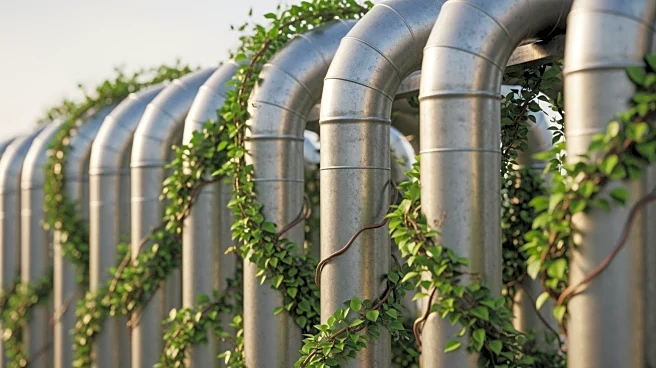What's Happening?
The mining industry is increasingly adopting tailings retreatment as a core component of modern mining practices. This approach involves reclaiming and relocating mining tailings to new, well-designed
facilities to mitigate environmental risks and recover valuable minerals. Harmony Gold, a prominent gold producer, is actively pursuing tailings retreatment as part of its environmental, social, and governance (ESG) commitments. The company aims to address both environmental risks and economic opportunities through these initiatives. Tailings retreatment not only helps extend the life of mines but also supports circular economy goals by making land available for other uses, such as renewable energy projects or agriculture. This practice is gaining traction globally, with South African companies leading the way in implementing innovative solutions for tailings management.
Why It's Important?
Tailings retreatment is significant as it addresses long-standing environmental concerns associated with mining activities. By relocating tailings to well-constructed facilities, the industry can reduce contamination of groundwater systems and support sustainable land use. This approach aligns with global standards for tailings management, which have become more stringent following major tailings dam failures worldwide. The economic benefits are also noteworthy, as retreatment can extend the operational life of mines, thereby sustaining their economic contributions to local and national economies. Additionally, rehabilitated land can be repurposed for renewable energy projects, contributing to the transition towards cleaner energy sources. The practice also offers social benefits by creating jobs and supporting local suppliers, enhancing community development.
What's Next?
The mining industry is expected to continue advancing tailings retreatment practices, with a focus on innovative solutions that ensure long-term environmental and economic sustainability. Companies like Harmony Gold are likely to expand their remining initiatives, creating more opportunities for post-mining land use. The adoption of geomorphic designs and sustainable cover systems will further reduce environmental impacts and costs. As global standards for tailings management evolve, mining companies will need to comply with these regulations, potentially leading to more robust designs and alternative uses for tailings. The industry may also explore underground storage options, provided they are environmentally friendly and commercially viable.
Beyond the Headlines
The shift towards tailings retreatment reflects broader trends in the mining industry, emphasizing sustainability and responsible resource management. This approach not only addresses immediate environmental concerns but also considers long-term impacts, such as the geotechnical stability of facilities and the potential for future land use. The integration of ESG considerations into mining practices highlights the industry's commitment to balancing economic growth with environmental stewardship. As tailings retreatment becomes more prevalent, it may influence regulatory frameworks and industry standards, driving further innovation and collaboration among stakeholders.











